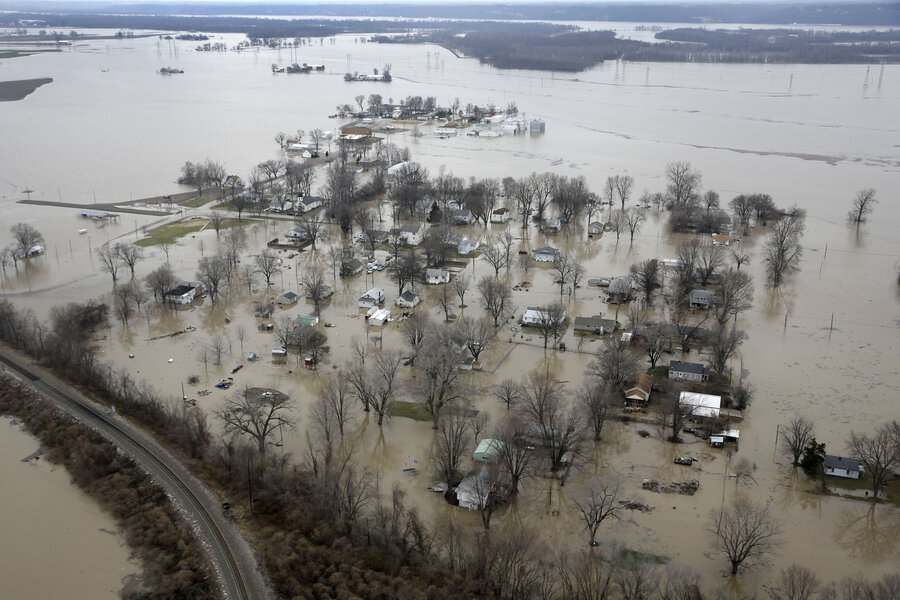At least 20 dead as flooding continues in central US
Loading...
| St. Louis
A rare winter flood threatened nearly two dozen federal levees in Missouri and Illinois on Wednesday as rivers rose, prompting evacuations in several places.
The US Army Corps of Engineers has deemed 19 levees highly vulnerable to flooding; by midday, those levees, all under close scrutiny, were holding up.
But people were moving out just in case, including the St. Louis suburb of Valley Park, where Mayor Michael Pennise ordered mandatory evacuations for 350 to 400 homes and dozens of businesses in the section of town near the fast-rising Meramec River.
Swollen rivers and streams have been pushed to heights not seen since the massive 1993 floods in some places. At least 20 deaths over several days in Missouri and Illinois were blamed on flooding, mostly involving vehicles that drove onto swamped roadways, and at least two people were still missing Wednesday.
And search teams went out for a third day in hopes of finding a country music singer from Arkansas who disappeared while duck hunting in a flooded area in northern Oklahoma. The floodwaters there also destroyed a leftover film set used in the 2003 remake of "Where the Red Fern Grows."
Some parts of interstates in Missouri reopened Wednesday, while others — including Interstate 44 near Valley Park — were still covered by water. Missouri Gov. Jay Nixon has activated the National Guard to assist with security in evacuated areas and to help keep road closure sites clear.
Valley Park City Attorney Tim Engelmeyer called the governor's office to send troops to help in the evacuated area of the about 7,000-person town. He was also watching computer projections of the crest — expected to be about 3 feet higher than the record of 40 feet on Thursday — knowing that an unexpected upgrade could be enough to send water over the levee.
"We're so close," he said. "We're talking about a potential 6-inch difference."
Pennise said the corps is confident the levee, built in 2007, is safe, but ordered evacuations as a precaution.
"You don't want to think negative, but we'd rather save a life than a couch," Pennise said.
Becky Bode, a 54-year-old postal carrier whose route includes lower Valley Park, said the area used to flood so frequently that residents mostly had flood insurance. With the levee, many don't.
Still, she's not worried about the residents.
"They've been through it before," Bode said. "If it floods, they'll pop back up and get going again."
In the southwestern Missouri tourist mecca of Branson, residents of about 150 duplexes and homes had to evacuate Wednesday due to flooding from a manmade lake. But the shopping district along the lake was still open, Fire Chief Ted Martin said, adding, "it has been packed with people, and I don't know where all of them have come from."
Sixty miles to the north in Pleasant Hope, the emergency management director said crews are looking for a missing motorist.
"Nobody that is living has ever seen anything like this," Rick Davis said.
Three-day rainfall totals of 9 to 11 inches were records in some parts of an area that stretched from southwest to east-central Missouri, said Mark Fuchs, a hydrologist for the National Weather Service in St. Louis. Rainfall totals of that magnitude occur only every 100 to 300 years, according to rainfall frequency data from the National Oceanic and Atmospheric Administration.
The Mississippi River is expected to reach nearly 13 feet above flood stage on Thursday at St. Louis, which would be the second-worst flood on record, behind only the devastating 1993 flood.
In the historic riverfront city of Alton, Illinois, some downtown business owners continued to scramble Wednesday to keep out rising water from the Mississippi River.
Most of the damage in the city 15 miles north of St. Louis, a stop on the 19th Century Underground Railroad, was confined to high water in some basements. Firefighters and emergency road crews worked to pump out water from flooded storm drains behind a seven-foot-high, 1000-foot-long temporary retaining wall reinforced by gravel and sandbags.
The Argosy Alton casino, which shut down on Monday, remained closed. So did the southbound lane of the main highway connecting the city to Missouri.
Alton Mayor Brant Walker said he's "very optimistic that what we've built here will hold" as the Mississippi River is expected to crest at 38 feet on Thursday, 17 feet above flood stage.
That confidence was of little consolation to Tim Meeks, who was loading vats of gourmet olive oil from his downtown market onto a trailer headed to higher ground as other employees worked to drain a basement filled with 7 feet of standing water.
"We don't keep anything down there anymore," he said. "All of our product has to go."







